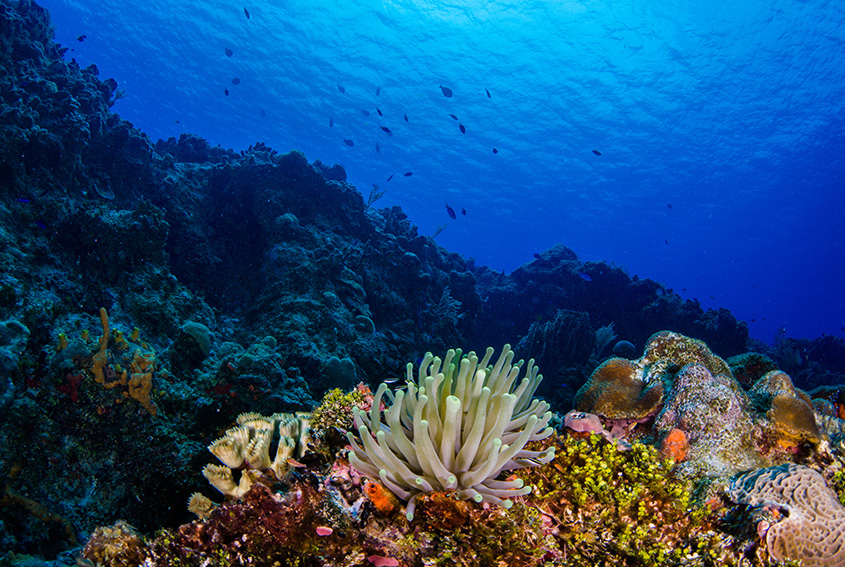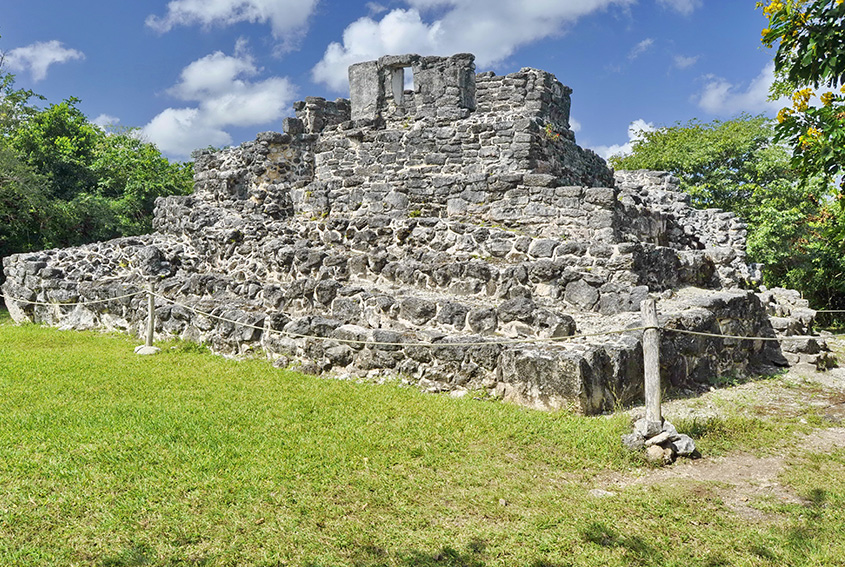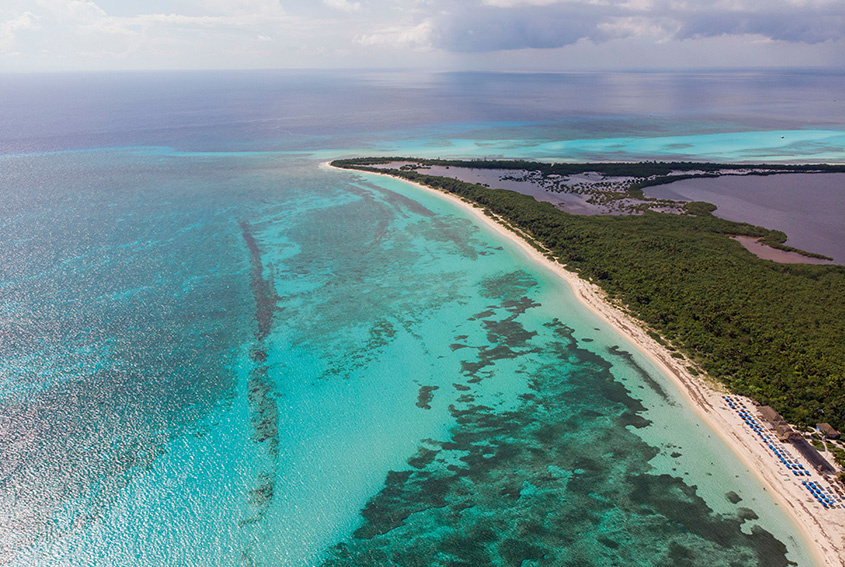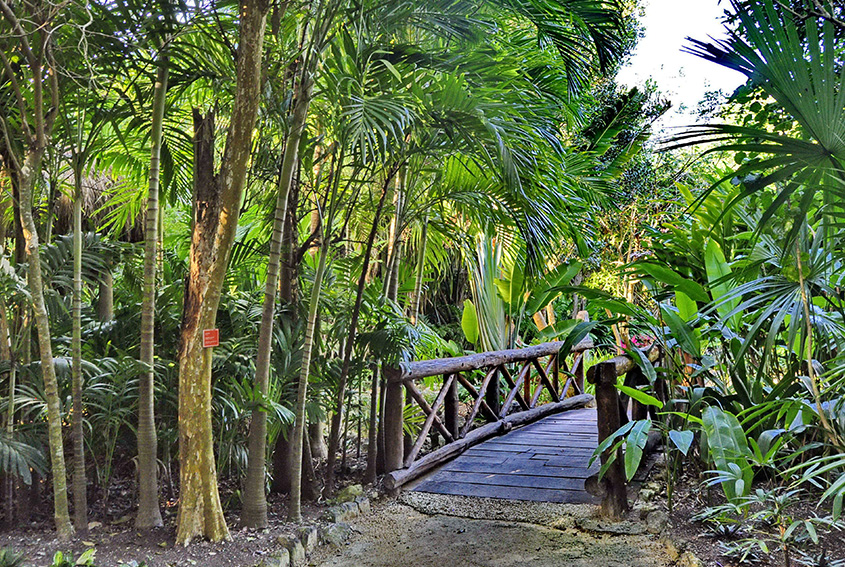This post is also available in:
![]() Spanish
Spanish
Sacred island of the ancient Maya and coral reef wonderland, Cozumel is only a short boat ride from Playa del Carmen. Cross a stretch of turquoise and indigo waters where dolphins often play and explore Mexico’s largest inhabited island. Breathtaking underwater beauty, palm-lined beaches and rich history and traditions await you.

Underwater Majesty
Most visitors to Cozumel are drawn by its spectacular coral kingdom, a chain of reefs off the west coast that was made famous by Jacques Cousteau and Mexican diver Rene Cardona. Magnificent coral buttresses and walls festooned by huge red, yellow and orange sponges – 47 species of coral and 48 varieties of sponge have been identified here – and gently waving sea fans are honeycombed with caves and canyons. The reefs are home to more than 300 species of fish and other colorful marine life of all shapes and sizes. Water visibility is as high as 200 feet and the current enables divers to practice drift diving and literally fly past coral walls and drop-offs descending into the depths, keeping pace with sea turtles, huge groupers and schools of eagle rays.
Cozumel’s reefs are part of the Mesoamerican Reef, the world’s second longest coral reef system and there are dives for every level of experience, from beginners to advanced, open water divers. Divers can spend a lifetime exploring reefs like Paraíso, Chankanaab, La Herradura, San Francisco, Yucab, Santa Rosa, El Tunel, Colombia, Maracaibo and the largest of them all, Palancar, famous for its coral pillars, caves and walls.
Some shallower reefs such as Chankanaab and Paraíso are great snorkeling spots and swimmers have their own up-close encounters with queen angelfish, parrot fish, blue tangs, sergeant majors and jacks. For visitors who would prefer to see the underwater world without getting wet, there are glass-bottomed boats and an unforgettable immersion on the Atlantis submarine, which dives to a depth of 100 feet.

Shrine to an Ancient Goddess
In ancient times, Cozumel or Cuzamil, “land of the swallows,” as it was known was held sacred by the Maya as the site of a shrine to Ixchel, goddess of the moon, the tides and fertility. Ancient temples can still be found in jungle clearings and there are lighthouses and lookout posts on the coast, testimony to the days of Mayan seafarers.
San Gervasio is the largest of Cozumel’s 25 archaeological sites and during the pre-Hispanic period it was a bustling city and a center of maritime trade. It was visited by pilgrims who would travel hundreds of miles overland from distant cities in the Yucatan and then make the perilous sea crossing from Xaman-Há (Playa del Carmen) and Pole (Xcaret) to worship at the shrine of Ixchel.
Each May, this pilgrimage is reenacted by hundreds of oarsmen and women who set sail from the bay in Xcaret in a fleet of wooden canoes bound for Cozumel on the Sacred Maya Crossing.

Coming of the Spaniards
In 1519, a Spanish expeditionary force led by Hernán Cortés landed on the island. From Cozumel, Cortes and his band of soldiers sailed into the west, landing on the Campeche and Tabasco shoreline. They crossed the Gulf of Mexico and made landfall on the coast of Veracruz. Lured by tales of gold, they moved inland, crossing the mountains and reaching Tenochtitlan, the Aztec capital, now the site of Mexico City. By 1521, this ruthless band and their Tlaxcalteca allies had overthrown the mighty Aztec empire, seizing its land and treasures.
During the Colonial period of Mexican history, Cozumel was largely forgotten, and its deserted shores became a haven for pirates such as Captain Henry Morgan and Miguel Molas. In the 1850s, the island was colonized by refugees fleeing the bloody Caste War on the Yucatecan mainland.
Located in the island capital San Miguel, the Cozumel Museum has interesting exhibits on the ancient Maya, the first Spaniards, the age of pirates, and the 19th-century colonization of the island. Other displays showcase local festivals such as the Carnival and the El Cedral Fair, which is held at the beginning of May.
Learn about the formation of the coral reefs and the island’s flora and fauna. The tropical forest and wetlands are rich in wildlife, including endemic creatures such as the pygmy raccoon, the Cozumel coatimundi, Cozumel golden warbler and the Cozumel emerald, an iridescent hummingbird.

Spend the Day Exploring
If you are not setting sail for a dive, snorkeling or fishing trip, rent a car, moped or a taxi and go exploring. Cozumel’s sheltered swimming beaches are all on the west coast. The rugged windward coast has some beautiful, deserted stretches of sand for a stroll although not for a dip as strong currents and undertow make swimming dangerous.
Other island attractions include Chankanaab, a nature park with a crystal-clear lagoon and reef for snorkeling, a cenote or sinkhole connected to the Caribbean by an underground river, a botanical garden and dolphin swims. Punta Sur nature reserve on the southern tip of the island and Isla de la Pasión are also worth a visit and are rich in birdlife.
Arrange a boat trip to El Cielo, a shallow reef and calm stretch of crystal-clear water where the seabed is covered with starfish. Take photos but don’t disturb these living treasures.
If you are interested in history, visit the island’s archaeological sites such as San Gervasio, El Cedral and Caracol.
Stroll through San Miguel, the island capital. There are plenty of craft shops and jewelry stores to catch your eye and when you are hungry, you won’t want to miss Cozumel’s famous fresh seafood. Watch the sun go down over the mainland on the waterfront or one of the west coast beaches before catching the ferry back to Playa del Carmen.
Thomas More Travel offers trips to Cozumel for diving or sightseeing or you can make your own way there at your own pace using the ferry from Playa del Carmen.

